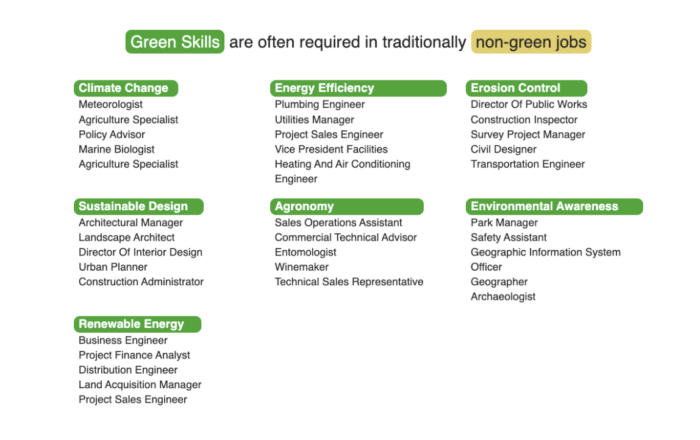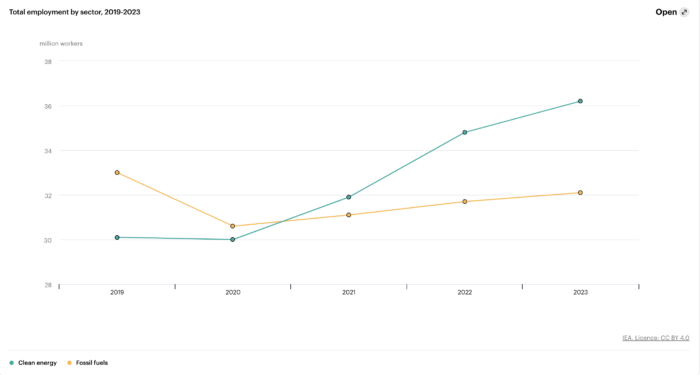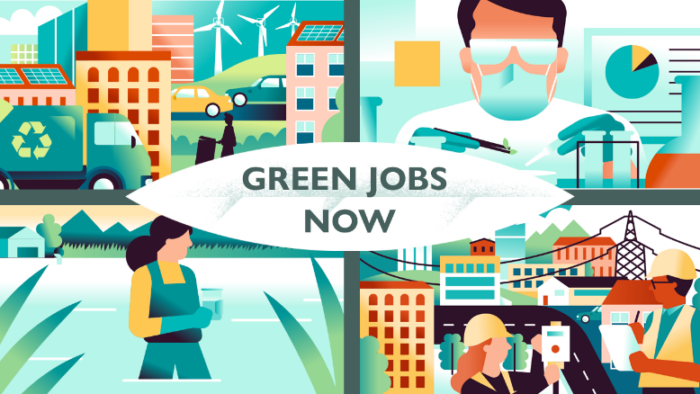-
2.0
-
2.1Climate and Curriculum
State standards are changing and green skills are easy to fit in.
-
2.2Reskilling Teachers
Making this transition requires reskilling our teacher workforce to know more about the demands of our shifting economy.
-
2.3Infrastructure
Greening facilities not only is a crucial part of reducing our carbon footprint, it also provides a great opportunity for students to learn hands-on.
-
3.0
-
3.1Global Trends
The United States are a decade behind many countries with regards to an energy and manufacturing transition. We can learn from their models
-
3.2Entrepreneurship
The green skills revolution creates a massive opportunity for opportunity spotting and new business development.
-
4.0
-
4.1Work-based Learning
Work-based learning opportunities can support college and career readiness by providing on-the-job training while students are still in high school. Why not make these opportunities green?
-
4.2Credentialing Examples
Credentials, micro-credentials and badges are all ways that students can show they have skills that align with postsecondary and/or industry needs and can be another way to address the skills gap in the green sector.
-
4.3P-TECH Examples
P-TECH requires coordination between secondary, postsecondary, and employers which lays the foundation for opportunities to integrate green skills and lead to green jobs.
-
4.4Dual Enrollment Examples
Many green jobs will not require a four-year college degree. With dual enrollment opportunities students will be able to get a head start without the burden of debt and time.
-
4.5Green Microschools Examples
Alternative and nimble school models allow for a focus on sustainability within, or outside of, a pre-existing school model.
-
5.0
-
5.1Workforce Development
Developing connections between education, businesses, organizations, and other community stakeholders promotes student success and can meet the workforce needs of a region.
-
5.2Asset Partnership
Schools are not simply a pipeline to the workforce but an incubator and launch pad for students who often want both successful and purposeful work and to give back to their communities.
-
5.3Microgrant Opportunities
Microgrants are small grants that are typically awarded at the local community-level. They can be a valuable first step in supporting student opportunities to explore green jobs and sustainability.
-
6.0
-
6.1
-
7.0

Key Takeaways

Demand Grows
Policies from the federal government and calls from the workforce indicate a huge workforce shift towards jobs that require green skills.

Future Forward
As we think about crafting high-quality accelerated pathways, we should consider building them toward the future society needs, rather than connecting young people with outdated careers.

Schools Have a Role
Many initiatives exist or are underway, but it will be up to schools and districts to tap into opportunities and facilitate these pipelines for youth.

Equitable Communities
Green jobs not only provide well-paid opportunities for youth they contribute towards cleaner, healthier, more equitable communities.
Introduction
Green skills will disrupt the world of work. From banking to business to healthcare, rapid and global adaptation to a changing environment will shift how we live and the jobs that we hold. Expert advice from organizations like the ILO, the OECD and the Department of Labor clearly indicates the growing demand and urgency for this seismic shift in purpose and process.
Regardless of one’s view on climate change, clean energy and clean manufacturing are not only better for our planet – they provide numerous economic, structural and equitable opportunities for both our young people and our communities. Are we providing pathways to help young people and our future workforce aquire the skills and dispositions needed to fill this exponential demand?
While many are working to better embed high-quality project-based learning, real-world learning and community-connected projects in K-12, we must also consider the ways in which we might point young people towards a sustainable future. This includes, but is not limited to, jobs that address and confront environmental justice, community climate challenges, sustainable supply chains and more. Schools have the power, and the responsibility, to play a guiding role in this work. United World Colleges has a great framework for what sustainability means at the level of dispositions and competencies.

LinkedIn Green Economy Report
As depicted in the 2022 Green Economy Report from LinkedIn, countless jobs will require green skills and not all of them will be in inherently green industries (manufacturing, agriculture, etc.). It is a core competency that all learners need to thrive.
Why Now?
Legislation like the Inflation Reduction Act (IRA) isn’t just about climate policy and incentivizing schools toward a cleaner future – it’s about jobs. A clean economy not only creates more opportunities, it also increases stability (e.g. enhancements to global supply chains) and renewed energy security. This transition towards sustainability will produce millions of well-paid jobs that have the capacity to rejuvenate our towns, reduce inequality, and revitalize communities.
Billions of dollars are being invested to help our nation make this energy transition, but at the moment we can only hope that we will have the human resources necessary to meet the demand of solar panel installation, wind turbine building and repair, materials sciences and infrastructure design and maintenance that will facilitate the transition to a greener economy.
Bill McKibben identified that “the two limiting factors of climate change will be whether we can overcome the fossil fuel industry’s meddling, and, whether we can build out above all the human capital that we need.” He then said, “I mean, the best estimate is it’s going to take at least a million more electricians in the U.S. [alone]. If you know a young person who wants to do something that’s going to help the world and wants to make a good living at the same time, tell them to go become an electrician.”

Green Jobs on The Rise
The 2023 World Energy Employment Report from the IEA shows that 2020 was the last year where fossil fuels employed more workers than clean energy. This graph depicts the rapid acceleration in green jobs.
The BlueGreen Alliance estimates over nine million jobs over the next decade alone from the IRA and other likely legislation with even higher estimates from some organizations – 23 million from the Advanced Energy Economy – that will stem from the passage of this bill. Industries include clean energy (5 million jobs), clean manufacturing (900,000), efficient buildings (900,000), natural infrastructure (600,ooo), clean transportation (400,000), and environmental justice (150,000). Indirectly we know this green transition will impact other careers like education, healthcare, law, business, and finance – everyone needs to be ready. Similarly, the Associated Builders and Contractors conducted a survey that, coupled with prospective construction data, indicates an employment gap of 546,000 construction workers in 2023 alone. A gap that must be readily filled and exceeded in order to adapt and grow American infrastructure.
Planet ED, an initiative of the Aspen Institute, published a brief on school infrastructure and CTE, making a similar call to “Invest in career and technical education programs to increase access to clean energy jobs and to integrate environmental sustainability across career pathways” and to “invest in youth to ensure an equitable and just transition.”
A recent summary of recommendations from IREC, a workforce development organization that builds the foundation for rapid adoption of clean energy and energy efficiency to benefit people, the economy, and our planet, includes: “[we must] develop and promote career pathways” and “integrate clean energy into existing education and professional development pathways.”

Green Jobs Now
Green Jobs Now is a content series from Working Nation designed to showcase the jobs potential within the green economy and how it is pivotal to the future of work.
The series explores green employment within each state via articles, podcasts, and videos that highlight employers who have embraced the green economy, as well as the training programs that are preparing jobseekers with the in-demand skills needed to thrive.
The green revolution is here, and legislation has created a tremendous opportunity for our students. We need to ask ourselves – are we doing what we can to facilitate this transition? Let’s help our students set foot on the right path.
A Greener Future of Work
At the 2023 Learning Planet virtual festival we facilitated a panel of experts on sustainability-focused CTE highlighting some of the amazing work being done in Colorado and Philadelphia to connect students with pathways to green jobs.

CREST Initiative and Growing Quality Jobs
JFF’s CREST Initiative recently analyzed nearly 200 million online job postings, finding that when the integration of current green skills into various occupations is considered, green jobs are more prevalent than commonly thought. This report leverages the Green Transformation Cycle to illustrate the economic transformation currently underway, and to better shape workforce training programs, employer talent pipelines, and emerging legislation to support the urgency of a just transition to a green economy.
Definitions
Green Jobs
Jobs that utilize green skills such as sustainability mindset, social entrepreneurship, systems thinking, new models of supply and demand, biomimicry and more.
Green Skills
Knowledge, abilities, values and attitudes needed to live in, develop and support a sustainable and resource-efficient society.
Pathway
High-quality awareness, supports and experiences that put young people on course for a future job, career or skillset.
Dual Enrollment
A program that allows high school students to take a college course and earn both high school and college credit. At its best, this dovetails with a pathway.
P-TECH
A school network where students earn a high school diploma, an industry-recognized associate degree, and gain relevant work experience in a growing field.
Career and Technical Education (CTE)
A program, leveraged by most US students, that prepares youth and adults for a wide range of high-wage, high-skill, high-demand careers through embedded industry-specific curriculum and experiences.
Inflation Reduction Act (IRA)
One of the most significant climate legislation in U.S. history, offering funding, programs, and incentives to accelerate the transition to a clean energy economy and will likely drive significant deployment of new clean electricity resources. Most provisions of the Inflation Reduction Act of 2022 became effective 1/1/2023. (EPA)